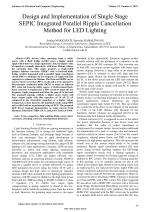| 4/2022 - 5 |
Design and Implementation of Single Stage SEPIC Integrated Parallel Ripple Cancellation Method for LED LightingMAKKAPATI, S. |
| Extra paper information in |
| Click to see author's profile in |
| Download PDF |
Author keywords
capacitors, light emitting diode, power factor correction, switching converter, total harmonic distortion
References keywords
power(21), electronics(16), driver(13), electrolytic(11), single(9), capacitor(9), stage(8), industrial(8), current(8), high(7)
Blue keywords are present in both the references section and the paper title.
About this article
Date of Publication: 2022-11-30
Volume 22, Issue 4, Year 2022, On page(s): 39 - 46
ISSN: 1582-7445, e-ISSN: 1844-7600
Digital Object Identifier: 10.4316/AECE.2022.04005
Web of Science Accession Number: 000920289700005
SCOPUS ID: 85150160610
Abstract
LED drivers when operating from a utility source with a diode bridge rectifier poses a higher output ripple which deserves a large capacitance. But, the higher value of capacitors, normally electrolytic, with lesser lifetime reduces the operating time. This paper proposes a single-ended primary inductor converter (SEPIC) with a front-end diode bridge rectifier integrated with a parallel ripple cancellation circuit (PRC) to eliminate the low frequency ac ripple with film capacitors to enhance the lifetime. The front-end SEPIC act as a power factor correction (PFC) circuit and is to be operated in discontinuous conduction mode (DCM) to attain an inherent PFC when fed from the utility source. A Bi-directional Buck-Boost converter is employed as a PRC circuit to ingest the low frequency ripple component and allow the pure dc to the load. The proposed topology exhibits a higher power factor and lesser output ripple with film capacitors of 10 uF, 22 uF compared to the electrolytic capacitors of a higher rating. Comparison is done based on the simulated results using PSIM and verified with an experimental setup of 30 W. The proposed LED driver topology demonstrates as input current Total Harmonic Distortion (THD) of 6.11, and power factor of 0.996. |
| References | | | Cited By |
Web of Science® Times Cited: 4 [View]
View record in Web of Science® [View]
View Related Records® [View]
Updated 3 weeks, 6 days ago
SCOPUS® Times Cited: 4
View record in SCOPUS® [Free preview]
View citations in SCOPUS® [Free preview]
[1] Design of a Double-Half-Bridge Rectifier With Single-Stage and Power Decoupling, Mayer, Giovano, Badin, Alceu Andre, IEEE Access, ISSN 2169-3536, Issue , 2023.
Digital Object Identifier: 10.1109/ACCESS.2023.3326133 [CrossRef]
[2] Design and Development of Modified Hybrid Resonant Converter with Valley-fill for LED Lighting, BALAKRISHNAN, L. P., RAMALINGAM, S., Advances in Electrical and Computer Engineering, ISSN 1582-7445, Issue 4, Volume 23, 2023.
Digital Object Identifier: 10.4316/AECE.2023.04002 [CrossRef] [Full text]
Disclaimer: All information displayed above was retrieved by using remote connections to respective databases. For the best user experience, we update all data by using background processes, and use caches in order to reduce the load on the servers we retrieve the information from. As we have no control on the availability of the database servers and sometimes the Internet connectivity may be affected, we do not guarantee the information is correct or complete. For the most accurate data, please always consult the database sites directly. Some external links require authentication or an institutional subscription.
Web of Science® is a registered trademark of Clarivate Analytics, Scopus® is a registered trademark of Elsevier B.V., other product names, company names, brand names, trademarks and logos are the property of their respective owners.
Faculty of Electrical Engineering and Computer Science
Stefan cel Mare University of Suceava, Romania
All rights reserved: Advances in Electrical and Computer Engineering is a registered trademark of the Stefan cel Mare University of Suceava. No part of this publication may be reproduced, stored in a retrieval system, photocopied, recorded or archived, without the written permission from the Editor. When authors submit their papers for publication, they agree that the copyright for their article be transferred to the Faculty of Electrical Engineering and Computer Science, Stefan cel Mare University of Suceava, Romania, if and only if the articles are accepted for publication. The copyright covers the exclusive rights to reproduce and distribute the article, including reprints and translations.
Permission for other use: The copyright owner's consent does not extend to copying for general distribution, for promotion, for creating new works, or for resale. Specific written permission must be obtained from the Editor for such copying. Direct linking to files hosted on this website is strictly prohibited.
Disclaimer: Whilst every effort is made by the publishers and editorial board to see that no inaccurate or misleading data, opinions or statements appear in this journal, they wish to make it clear that all information and opinions formulated in the articles, as well as linguistic accuracy, are the sole responsibility of the author.



